
About this time last year, in July, an attack on a dera in Austria sparked violence in Punjab. Six men have now been 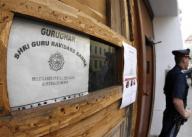 charged- one with murder, and five with attempted murder as accomplices – for the initial attack in Vienna.
charged- one with murder, and five with attempted murder as accomplices – for the initial attack in Vienna.
A 35-year-old man has been charged with murder and two counts of attempted murder, a Vienna court spokesman said. The five others are charged with being accomplices in attempted murder and with attempted severe assault on the worshippers. [link]
The five charged as accomplices are planning on pleading not guilty. [link]
The thirty-five year old charged with murder claims that he suffers from memory loss “after being subdued by worshippers wielding frying pans, a rolling pin and a microphone stand. The defence said it would submit a psychiatric assessment to the court.” He’ll be submitting a psychiatric evaluation to assess any such loss.
 I am assuming many in Canada probably don’t need an introduction, but as I just discovered the young boxer, I figure I could put the rest of the Langar Hall in the know.
I am assuming many in Canada probably don’t need an introduction, but as I just discovered the young boxer, I figure I could put the rest of the Langar Hall in the know.
This past weekend the young Sikh fighter lost to Jose Silveira of Mexico for the NABA bantamweight title. The loss was due to a judges’ decision after the referee called off the fight after Kooner suffered a cut to the nose from an accidental headbutt by Jose.
Possibly more interesting than this past weekend’s result is Andrew’s story.
In an interview with the Toronto Star, Kooner gave insights into how he got into boxing:
Born in Kettering, England, Kooner immigrated to Canada with his parents as a three-year-old. When he was 13, he joined the local Windsor Boxing Club, not because grew up a fight fan. He was one of the very few Sikh kids in his school and was being singled out on a regular basis.
“I was being tormented a lot,” he said, “and my parents felt boxing was a good way to channel my anger and frustration. Boxing ended up being a blessing.”[link]
The boxer has made previous Olympic appearances, the last time in 2004. Check out his website when you get a chance as well as pictures from his last fight. Talk about a Babbar entourage!
I guess I have a new favorite boxer. What ever happened to Pardeep?
Guest blogged by Harkiran
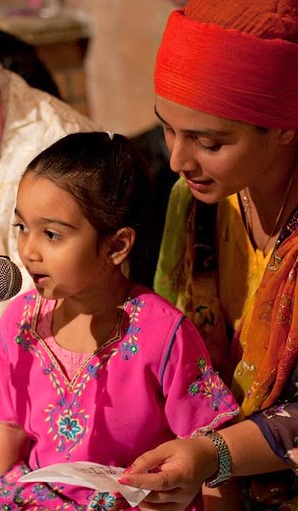
Becomes the first house of the man and yet it’s ironical, that its the woman that seeks a shelter all her life. As she grows up she leaves her house and her family to start a new life with her husband and then her own womb becomes the place where life comes to existence and get’s nurtured. Years of duality and other kind of “loves” doesn’t let man do justice even to the woman he calls mother.
There’s the Bani of Nanak that does justice to the status of a woman in society and then this Vaar by Bhai Gurdas Ji.
The Woman – Bhai Gurdas Ji
Vaar 5 Pauri 16
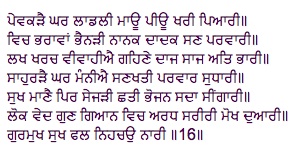
At birth a Sikh girl is ‘darling’ to her mother and father/ Later, she becomes admired by her brothers and sisters and favoured by her relatives / On attaining to ” the bloom of youth” she is wedded with costly gifts and presents / Now, respected by her husbands family and deemed lucky in her new household, she regarded as the equal of her spouse in both virtue and wisdom / She becomes as a doorway to salvation.
This beautiful verbal portrait written by Bhai Gurdas Ji not only makes you appreciate the beauty of a woman and but also puts ones mind in their creator too.
Guest blogged by Jind Kaur
For my inaugural [guest] post on The Langar Hall, I wanted to discuss something that is often on my mind when I think about our faith and how to practice it: the concept of sangat (the congregation). The Guru Sahibaan often impressed upon us how we should not isolate ourselves from the world in order to find salvation. We are taught that we must live amongst the world, and it is from the sangat where we learn and practice the teachings the Gurus pass on to us. “Satsangat Satgur Chattsaal Hai, Jit Har Gunh Sikha” “The Sat Sangat, the True Congregation of the True Guru, is the school of the soul, where the Glorious Virtues of the Lord are studied.” Participation and engagement with the sangat is considered essential for a Sikh’s spiritual progress. It is in the sangat that we worship and in the sangat where we are to receive training in our faith and its daily application. The sangat is our holy fellowship where we may become morally elevated.
But where is our sangat? Is our sangat in our Gurudwara, out in the world or some combination of both? Sometimes when I see the current state of our Gurudwaras, regardless of geography, it makes me want to stay home to pray quietly by myself and find other ways to do seva where it is needed. There is an epidemic of politics overtaking our Gurudwaras. However, this is enabled and encouraged by the absence of a true sangat.
When I was a teenager attending a particular Sikh camp, (I don’t want to date myself), I attended a lecture/discussion that has permanently imprinted itself in my mind. The man who led the discussion taught us about the root of the word “sangat” – this is “sang” (pronounced “sung”), which means “together”. Your sangat consists of those whom you walk with together in life. This led me to ask, not only where my sangat is, but who is in that sangat.
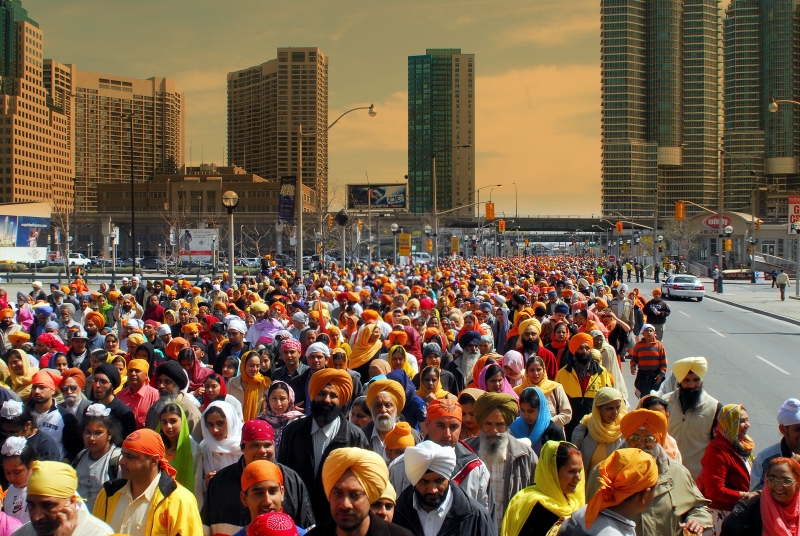 A few weeks back, we attended our first Sikh Parade of the season.
A few weeks back, we attended our first Sikh Parade of the season.
Like every year, we love making the trip downtown to join our sangat and spend a beautiful spring day outside celebrating Vaisakhi. Amongst the sea of kesri dastaars and chunnis, there was keertan, gatka, and jakaaray filling the streets.
As we began marching down the main avenue, I started to notice the passerby’s reaction to us. Some were irritated they had to wait for us to cross the street, some took out their camera phones to take pictures of us, but the vast majority looked, well…confused.
And who can blame them?
None of our floats and few of our signs would make any sense to a non-Sikh. The overlapping keertan, jakaaray, and political slogans were obviously all in Punjabi. And there was little to no interaction between us and the onlookers. I wondered, why did we come here to do this?
If our purpose was to have a nagar keertan and to celebrate Vaisakhi in our own traditional way, then why waste the time and money to do it out here? Why not just do this on our own Gurdwara premises? But if our purpose was to educate the greater community on who Sikhs are, then what exactly were we doing to accomplish that? Sure, many people were taking pictures of us, but was it because of the spectacle we created? Or because people were so happy to see the Sikhs that they’ve heard so much about – followers of Guru Nanak, brave soldiers, and defenders of the downtrodden? Which do you think?
Continue Reading »
As many of us reflect upon the birth of the Khalsa this Vaisakhi, throughout North America (and beyond) our communities come together in celebration. Covered here is a round-up of Vaisakhi celebrations with various media links. If your city is covered here, provide us some context/anecdotes about your experience. If your city is NOT covered here, provide us some context/anecdotes about your experience.
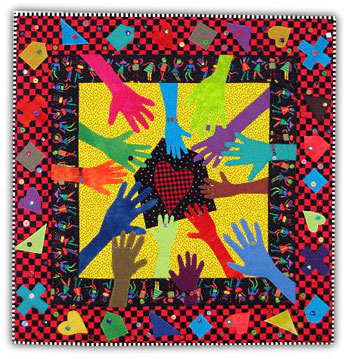 A few years back, I went to my first Charni Lagna ceremony. Charni Lagna – literally, “at the feet of the Guru” is the traditional name of the event where a Sikh formally begins reading from the Guru Granth Sahib.
A few years back, I went to my first Charni Lagna ceremony. Charni Lagna – literally, “at the feet of the Guru” is the traditional name of the event where a Sikh formally begins reading from the Guru Granth Sahib.
Like most Sikh ceremonies, it is actually quite simple. After shabad kirtan is recited, an ardaas is offered for the young (or old) Sikh who is beginning their journey with the Guru – then finally, he or she will read the hukamnama.
The ceremony I attended was for an 11-year old girl, who was very excited and worked hard to prepare for this day. After a few shabads were sung by the local jatha and the girl’s friends – one by one, members of the sangat came to say a few words of encouragement. One of her friends was around the same age and similarly went through this ceremony a year prior. She spoke about her own experience reading from the Guru Granth Sahib on a daily basis and how it has changed her life. Then one of her friends who had yet to take this step spoke of how she was inspired to do so soon. Then came her Punjabi school teacher, then her camp counselors, then other leaders of the community. I noted that neither her parents nor any of her relatives spoke – but instead, they just sat and listened to the members of the sangat, who individually shared such beautiful words of encouragement and praise for this young Kaur, who humbly sat at the feet of the Guru…It was quite powerful.
Finally, as the ardaas ended, there was a rare moment of pin-drop silence in the darbar hall. Then this brave 11 year old girl, surrounded by her proud parents and grandparents, read the hukamnama flawlessly…I was moved by the whole event.
Immediately after the hukmanama was completed, something remarkable happened…
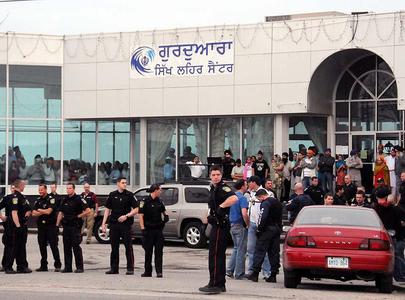 As many Sikhs throughout the world are gearing up to celebrate Vaisakhi, we continuously get disheartening news as well. In Toronto there was a shameful incident this weekend.
As many Sikhs throughout the world are gearing up to celebrate Vaisakhi, we continuously get disheartening news as well. In Toronto there was a shameful incident this weekend.
A former judge, now a prominent Brampton lawyer, is in hospital with serious stab wounds when a mob turned deadly at a Sikh temple on Friday evening.Manjit Mangat, 53, is in hospital with multiple stab wounds to his abdomen, thighs and legs and cuts on his face after he was attacked inside the Sikh Lehar Centre, a temple at Bramsteele Rd. near Steeles Ave. and Hwy. 410.[link]
The worst exhibit I saw ..and I know BOTH sides are guilty of this, was the declaration that the other side are not Sikhs. Both sides need to mature and grow up. I hope the Sikh youth can provide a better example for our elders.[link]
Last week, many in US Sikhdom celebrated the triumphs of Captain Tejdeep Singh Rattan and Dr. Kamaljeet Singh Kalsi. For why you may ask? See previous coverage.
The NY Times Printed this short brief:
Capt. Tejdeep Singh Rattan, in a turban and full beard, graduated Monday at Fort Sam Houston in San Antonio, the first Sikh in a generation allowed to complete Army basic training without sacrificing the articles of his faith. The Army made an exemption to a uniform policy that has effectively prevented Sikhs from enlisting since 1984. “I’m feeling very humbled,” said Captain Rattan, 31, a dentist. “I’m a soldier.” He had to get a waiver from the Army to be allowed to serve without sacrificing the unshorn hair mandated by his faith. An immigrant from India who arrived in New York as a teenager, Captain Rattan said it was important for him to serve a country that has given him so many opportunities. Captain Rattan and Dr. Kamaljeet Singh Kalsi, who will attend basic training this summer, are the first Sikhs to receive exemptions in more than 25 years. [link]
Sikhs should absolutely have the opportunity to enter the military if they so choose; I will leave my opinion on the imperial adventurism in Iraq and Afghanistan for another time. Still from talking to other Sikh friends in the military, I wonder about Sikh Coalition’s press release stating “First Sikh US Army Officer Successfully Completes Basic Training” does some disservice to others in the military. That non-keshadhari Sikhs have served in the US army in the past is well known, especially the case of Uday Singh. Although the Coalition deserves kudos for their success for creating an opening for keshadhari Sikhs to also serve, does it also play up on a class factor by celebrating only officers, rather than the many nameless ground troopers?
 I read about this story and it just broke my heart. The details are tragic in and of themself, however, the indication that our community somehow failed this family is even more heartbreaking.
I read about this story and it just broke my heart. The details are tragic in and of themself, however, the indication that our community somehow failed this family is even more heartbreaking.
On February 21st, 2010 – Satnam Singh was shot to death by NYC police. A few days later his mother, Balbir Kaur, lay in a hospital bed recovering from being hit with a pan repeatedly by her son who suffered from a mental illness. When the NYC police arrived at the home – Satnam who had suffered an episode of an anxiety attack – was unable to articulate the situation. The police, seeing the mother bleeding on the couch – shot Satnam several times. He later died. Balbir Kaur’s other son, Lakhvinder Singh had in fact called the police. As he lay in a hospital bed preparing for treatment for a medical condition, he worried that he had not heard from his mother in some time. Their father, Bahadur Singh had recently traveled to Punjab and therefore, Balbir was alone at home with Satnam.
Balbir was the sole caretaker of her sons and husband. Satnam was suffering from a mental illness, Lakvinder was in a wheelchair after an accident, and Bahadur had his feet amputated due to gangrene infections. After the incident, Balbir lay in a hospital for days without a friend or family member by her side.
The local Punjabi language newspaper reports that since no one in the community knew the family, their suffering for years, including the latest episode, were unknown to anybody in Sikh circles. I somehow find it impossible to believe that the unfortunate family would never have visited any gurdwara the whole time they were there. Why did anybody not befriend them? Why was a support system not extended to them? Why was a newly migrant woman left to fend and care for her family of 3 disabled men on her own? [link]
Earlier this month a congressional hearing reviewing the Transportation Security Administration’s 2011 Fiscal budget occurred in committee. Representative, John Culberson (Republican from Texas) demanded to know why the US government refuses to engage in racial and religious profiling, when screening at airports.
The Representative stated:
It is disturbing [the TSA policy against profiling]. I mean it is something that needs to change. It just defies common sense.
SALDEF responded by issuing a letter a to the Congressman reminding him it is against the US Constitution to profile based on religion. In a rising climate of gross Muslimophobia, Sikhs are ‘racialized Muslims’. We must stand in solidarity against such practices. I am glad that Sikh groups are paying attention.
Due to unforseen circumstances, we were notified that the webinar has been postponed until Saturday, March 27, 2010. Register at the link provided below.
—————–
A few months ago, RP Singh wrote a wonderful review of a new children’s book called A Lion’s Mane by Navjot Kaur. The book takes young readers on a journey to cultures around the globe to explore the meaning of the dastaar. The book does an excellent job at celebrating diversity and encouraging inquisition in young readers. While the main character in the book is a young Sikh boy, the author and illustrator worked hard to create a story that was accessible to both young boys and young girls.
Educators are now asking – how can we create gender neutral curriculum and cultivate an environment of bias-free learning? In a webinar titled, “Gender Neutral Teaching: A Sikh Context,” the Sikh Research Institute will be opening this topic up for discussion and looking at gender neutral teaching from a Sikh context. We have an important role as a community to help to facilitate these discussions and ensure that our children and their children have the opportunity to learn in an environment that celebrates diversity. Below you will find information on how to register for this webinar. It sounds like an enlightening and much needed conversation!
Gender Neutral Teaching: A Sikh Context
Presenter: Jasmine Kaur, Director of Education at the Sikh Research Institute
Register here.
The details are still very sketchy, but it seems that a dera associated with the highly controversial Maan Singh Pehowa was burned down in Sacramento this past weekend. Maan Singh has been accused of rape.
I write this post partially to clarify that it was not at a Gurdwara in Sacramento, as well as to give a place for discussion and thoughts. The police seem to have some indication that the fire was not an accident, although very few details are being provided. Could it be an arson against immigrants? Could it be an accident? Could it involve frictions within the Sikh community in Sacramento? I do not know. I would be interested to hear thoughts, especially from those readers in Sacramento.
A video from the local news about the fire can be viewed here.
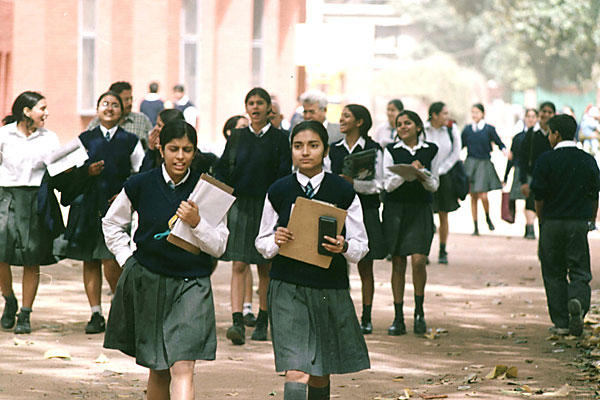 As communities around the world celebrated International Women’s Day yesterday, there were several interesting articles discussing the role of women in the world. Nicholas Kristof wrote about Three Proven Steps to Advance the World’s Women (education, micronutrients, and helping women start businesses). Another article talked about The World’s Best Countries for Women. The Christian Science Monitor discussed Gender Selection – an issue which we have often dialogued about here on TLH. The article talks about the repercussions of sex selective abortion – specifically, the gender imbalance leading to fewer women available to be wives.
As communities around the world celebrated International Women’s Day yesterday, there were several interesting articles discussing the role of women in the world. Nicholas Kristof wrote about Three Proven Steps to Advance the World’s Women (education, micronutrients, and helping women start businesses). Another article talked about The World’s Best Countries for Women. The Christian Science Monitor discussed Gender Selection – an issue which we have often dialogued about here on TLH. The article talks about the repercussions of sex selective abortion – specifically, the gender imbalance leading to fewer women available to be wives.
Villagers here say that the dearth of females has already had a direct effect on dowry customs: Dowries are getting smaller or disappearing altogether; instead, the onus is increasingly on young men to provide well for their future brides… Baljeet Singh, a 37-year-old truck driver, says he began to despair of finding a local wife once he turned 26. Men in this village, where most are farmers, consider it ideal to wed between 20 and 25. “I’m a van driver, I don’t have many prospects, and it seems that you have to have a very good job to get a bride these days,” he says. So last year, Mr Singh used his life savings to marry a 16-year-old Muslim girl from Assam; though village rumors have it that Sonu Khutum is an illegal immigrant from Bangladesh. She is happy to be living in a predominantly Hindu village, she says, joggling the couple’s 7-month-old baby girl on her hip. But lonely bachelors’ new quick fix, buying brides from impoverished parts of India, seems likely to do little to enhance the status of women. [link]
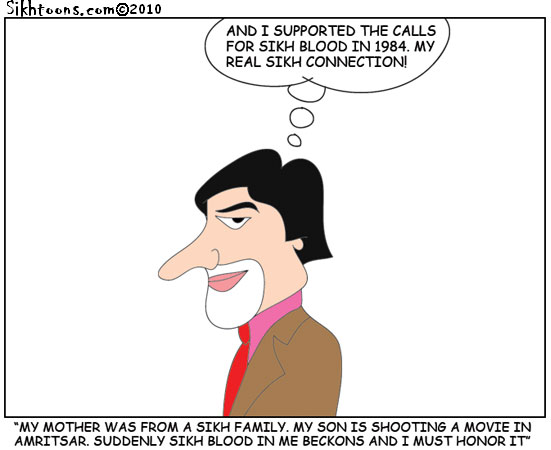 Of some note to Sikhs, members of the Bachchan actor family has caught the fancy of the Indian press in relation to our faith. It started with Amitabh Bachan’s blog post, where he wrote:
Of some note to Sikhs, members of the Bachchan actor family has caught the fancy of the Indian press in relation to our faith. It started with Amitabh Bachan’s blog post, where he wrote:
Abhishek shoots Bingo in the Holy City of Amritsar and his sister Shweta joins him to pay homage and prayer at the Harmandir Saheb. I wish I could do the same, but am unable to. Soon however I shall find the time. Or as they say in such situations, when the time comes He will call you and providence shall make the right moves and ways to permit us to do so. The Sikh blood in me beckons and I must honor it. It is rather strange, but in the last few months, my attraction and interest towards my Sikh links, attain some prominence and I feel drawn towards it. Two lockets of Guru Nanak ji, Sacche Padsha, are constant on my neck – one a gift from Guddi Behenji my cousin, daughter of my Mother’s elder sister Gobind Masi ji and the other I found as a gift to me that was lying on my desk unnoticed. Now they both adorn my neck. Raj Kanwar, one of Abhishek’s early directors had presented me with a photograph of all the Guru ji’s and they now are with me at my place of worship. I seek blessings from them each morning – ‘Sat Naam Wahe Guru’ , I recite, as I touch their images and a strange sense of fulfillment and strength consumes me.[link]
Now many Indian press website running headlines – “Big B Feels Drawn Towards Sikhism” and the like. New headlines are now coming out about his son – Abhishek – performing seva at Darbar Sahib.
While many Indians and even some Sikhs are impressed, I can’t help but have little care. Maybe it is because of long allegations in the community that have never been dispelled.
Amongst the male youth in Punjab, drugs are a serious problem today. With high unemployment rates, and a 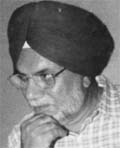 history of violence in the region, the environment is ripe for drug abuse. A Punjab government survey found that one out of three male students use at least a form of tobacco. And on a recent trip to the region, as we were driving between pinds, my relatives pointed out the jeeps, distinctive with their black lights, that carried young drug dealers. The young men sitting inside were all in their teens.
history of violence in the region, the environment is ripe for drug abuse. A Punjab government survey found that one out of three male students use at least a form of tobacco. And on a recent trip to the region, as we were driving between pinds, my relatives pointed out the jeeps, distinctive with their black lights, that carried young drug dealers. The young men sitting inside were all in their teens.
In response, Ajmer Aulakh, a well known Punjabi professor and writer has written a play, “Avesle Yudha Di Nayika” (An Unsung War Heroine), that recently attracted a large audience at the Government College for Boys in Ludhiana.
Aulakh is a noted playwright, artist and winner of Sahitya Akademi Award. He has dedicated his life to theatre and generally works on issues and problems confronting the common man. [TOI]
This much-needed play had students riveted, incorporating Punjabi poetry.
The play highlighted the menace of drugs, delineating how a family loses everything to the evil. Jodha Singh, a villager landlord, is survived by his wife and two children. Satwant Kaur, wife of Jodha Singh, wants their kids to go to school and study, but owing to drugs, the family property is lost. The play portrays the consequent struggle. It depicts how she fights odds to enable her children to continue their studies. The play was performed by artists who are part of Lok Kala Manch and was supported beautifully by Punjabi poetry. [TOI]
The young researchers that presented at last week’s Sikholars conference have made their papers available. Until March 15, 2010 they will be available at this link.
If you read the papers, we would love to hear your comments.
International Women’s Day is celebrated on March 8th each year and is a major day of global celebration for the economic, political and social achievements of women. We have previously posted about well known examples of women in our history who have made huge contributions to Sikhi. Perhaps on this day we can take the time to continue recognizing the numerous Sikh women who stood alongside Sikh men to help our qaum. I recently read about twenty Sikh women in a document titled, “Noble and Brave Sikh Women” by Sawan Singh. The author writes,
Bibi Rajinder Kaur and Bibi Sahib Kaur both belonged to the royal family of Patiala state. Their bravery in the battlefields and their skills in administration saved the state from being ruined. Mata Kishan Kaur and Bibi Balbir Kaur took part and suffered in the Akali movement for the control of Gurdwaras. Bibi Balbir Kaur even sacrificed her own life and that of her innocent child in this movement. Bibi Harnam Kaur has done wonders to spread female education among the Sikh women a hundred years ago. Mai Bhag Kaur has proved that Sikh women can lead and organize the Sikh men and win battles. Women martyrs of Shahid Gunj of Lahore like Bhghel Kaur cannot be found in the literature of many religions. Bibi Sharan Kaur and Bibi Shamsher Kaur have proved their skills in the battlefield and in administration. Bibi Anoop Kaur, Bibi Shushil Kaur, Bibi Harsharan Kaur, Bibi Basan Lata and Bibi Nirbhay Kaur have faced odds and sacrificed their lives to save their honor and faith.
The document is a great starting point to begin learning about the immense history of Sikh women that often goes untold. Are there any events in your community being planned for International Women’s Day? How do we, in general, recognize the contributions of women in Sikh history?
On TLH we have addressed various issues effecting the South Asian elderly community. The recent news article in the the New York Times on the difficulties encountered by many Sikh seniors in the California Bay Area was particularly heart wrenching.
In an article in New America Media, Paul Kleyman discusses the impact of depression on ethnic seniors. Many of his statements of seniors feeling alone and depressed resonated with the stories I have heard about Sikh seniors. I have often heard how Sikh seniors feel like America is a “sweet prison”. You have many material benefits, but also a tremendous amount of social isolation. Even when living with their children and grandchildren, the elderly miss their social life back in Punjab. In the US, the elderly spend the majority of their day separated from their children and grandchildren in time and space. Also, generational gaps coupled with cultural differences create social and emotional distance.
Kleyman writes that ethnic seniors are expected to have similar levels of depression as the white elderly population (about one in six people ages 50 and above), but the main difference is:
“… that African-American, Latino, Asian and Native-American seniors are less apt to get treated. That’s because of their higher levels of poverty, lack of insurance or access to treatment and the pervasive stigma of mental illness in many cultures. Left untreated, depression, anxiety disorder and related conditions can result in debilitating physical ailments, as people eat and sleep more poorly and become less physically active. ”
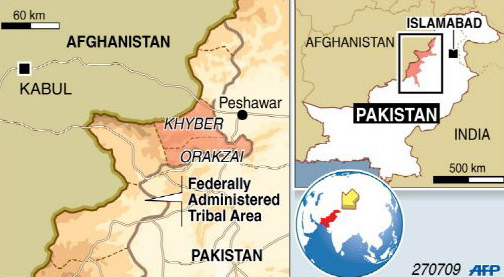 It seems to be the talk of the community. Two Sikh men are claimed to have been beheaded by the “Taliban”. I do not have any independent details, but do believe we should make sure we understand all the information.
It seems to be the talk of the community. Two Sikh men are claimed to have been beheaded by the “Taliban”. I do not have any independent details, but do believe we should make sure we understand all the information.
The BBC has reported the beheadings of Jaspal Singh and Mastan Singh in the Khyber and Orakzai areas. The two men had been abducted and extortion money was demanded to the family. The BBC has made no mention of the Taliban, although this is widely being reported by the Indian media.
With the breakdown of law and order following the 2001 invasion into Afghanistan, we have seen a complete deterioration of law and order. Many seem to be claiming that the Taliban caused this, but in a situation without security, it will be difficult to find out who are the real culprits. The area is infested with criminals.
The Taliban is hardly a united grouping. Scholar, Juan Cole, states that there are at least 4 different groups. Further confusing the situation, it must be remembered by the Sikhs that the “Taliban” in the same region rescued Sikhs before.
With this in mind, I am eager to hear thoughts.
